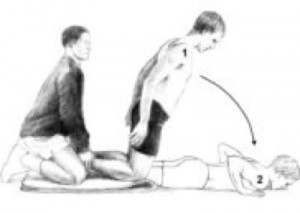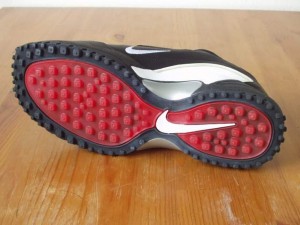Brian Schiff’s Blog
Injury Prevention, Sports Rehab & Performance Training Expert
Well, Thanksgiving is upon us in 2011. I want to wish you and your family a wonderful holiday. In today’s post I will review a November 2011 article in the American Journal of Sports Medicine that looked at the effect of the Nordic hamstring exercise on hamstring injuries in male soccer players.
For those not familiar with Nordic hamstring exercises, see the photo below:

In this randomized trial, the researchers had 54 teams from the top 5 Danish soccer divisions participate. They ended up with 461 players in the intervention group (Nordic ex) and 481 players in the control group. The 10 week intervention program was implemented in the mid-season break between December and and March because this was “the only time of the year in which unaccustomed exercise does not conflict with the competitive season.
The trial was conducted between January 7, 2008 and December 12, 2008 with follow-up of the last injury until January 14, 2009. In the intervention group, all teams followed their normal training routine but also performed 27 sessions of the Nordic hamstring exercises in a 10 week program (as follows)
- Week 1 – 2 x 5
- Week 2 – 2 x 6
- Week 3 – 3 x 6-8
- Week 4 – 3 x 8-10
- Weeks 5-10 – 3 sets, 12-10-8 reps
- Weeks 10 plus – 3 sets 12-10-8 reps
The athletes were asked to use their arms to buffer the fall, let the chest touch the ground and immediately get back to the starting position by pushing with their hands to minimize the concentric phase. The exercise was conducted during training sessions and supervised by the coach. The teams were allowed to choose when in training it was done, but they were advised not to do it prior to a proper warm-up program.
And the results…..
In my last post, I shared some practical plyometric drills with you to help teach proper landing mechanics in an effort to reduce ACL injuries. Yesterday, I presented my comprehensive approach to knee training at our ACL Symposium in Cary, NC.

One of the fundamental errors I see coaches and athletes make is abandoning their pre-season training efforts during the in-season. While athletes need to spend the majority of the in-season focusing on sports skills, they must also maintain the neuromuscular training adaptations acquired in the off-season and pre-season.
In my mind, the phrase “use it or lose it” is applicable for the neuromuscular training effects we see with balance, strength, agility and plyometric training. This is especially true for our high risk female athletes like soccer and basketball players who suffer knee sprains, ACL tears and patellofemoral pain at disproportionate rates.
I often hear coaches say, ” I don’t have time to get workouts done and still accomplish what needs to be done at practice.” While, time management may be difficult, I think coaches could probably squeeze in a single training session lasting 15-20 minutes if they simply knew how important it was to the overall health and performance capacity of their team.
With that said, I like to offer simple, yet effective exercises that can be done on a court or field with the whole team simultaneously without the need for expensive equipment. Exercises should focus on activating the glutes (including the medius and minimus) as well as training the hamstrings more since most female athletes tend to be quad dominant.
These exercises are just as effective for males too. So, in the video below I will reveal some exercises I prefer to do to increase strength and reduce injury risk. Perform 2-3 sets of 8-15 reps focusing on strict form throughout.
It has been known for years that increased coefficient of traction can predispose the knee to catastrophic injury. Hence, the reason we got rid of all the old style astro turf in football stadiums. But, traction is influenced by the sole architecture of the shoes as well as the playing surface. Unfortunately, we are not fully aware of how exactly the sole architecture or this increased traction can lead to injury.

Nike Astro Turf Shoe
Does footwear really matter? I say YES. Case in point – I am not a big fan of Nike Shox because they position the ankle in a plantar flexed position, thereby making it so much easier for ankles to roll inward with cutting. I have seen too many female athletes suffer inversion sprains while running suicides or training in these shoes. I simply believe the design creates a biomechanical mismatch and elevated risk for ankle sprains.
Now what about traction? A study in the American Journal of Sports Medicine by J Wannop et al. recently looked at the difference between two shoe designs in a controlled laboratory study. The tread types of shoes used were either smooth or tread.
The shoe used in the study was the adidas Response 2+ CPT (smooth shoe) and adidas Response=2(A) (tread shoe). The traction testing was performed using a robotic testing machine, while the researchers also observed 13 recreational athletes performing 45 degree V cuts in both shoes. Data was collected using 8 high speed cameras and a force plate.
The results are not shocking. The highlights are:
- The coefficient of translational traction and peak moment of rotation were both significantly higher in the tread show compared to the smooth shoe.
- In addition, the high-traction shoe had much higher peak ankle externalrotation moments, peak knee external rotation moments, peak knee adduction moments, and knee adduction angular impulse compared to low-traction shoe.
The findings of the study indicate that the resultant joint loading increased 12% in the ankle (transverse plane) and 13% and 20% in the transverse and frontal planes for the knee. This increased traction is certainly enough to push the knee into the previously reported mechanical rupture zone.
What we cannot deduce is whether the increases in joint loading is strictly attributable to the higher linear and rotational traction or if there is even a linear relationship between them at all.
You should also note that athletes often choose traction shoes for enhanced performance. In this study, there was no significant difference in the performance measured between the two groups. So, we are left to ponder whether we really need higher traction shoes at all. Future studies will need to address this relationship as preventing knee and ankle injuries just by adjusting footwear seems like a no-brainer if the science supports this.
So, I was meeting with a 14 y/o soccer player referred to me by a physical therapist today who is need of sports performance conditioning (return to play) work after a lateral release. This talented female athlete suffers from a shallow trochlear groove, thereby making her more prone to patella subluxations.
Such an incident led to two recent surgeries and nearly a year away from the soccer field. She has returned to soccer, but has been referred to me for prevention and performance work. I have been thinking about her program, history and all the athletes I have trained in recent memory with knee problems.
I also recall reading an email this weekend from a past intern asking me if there was a single leg training certification out there as she saw me do so much of it at my facility. These thoughts lead me to my post today. If you are a jumping, cutting or competitive athlete using your legs to perform, you should absolutely be integrating single leg training into your conditioning programs.

Why, do I say so? The answer is rather simple in my mind. The human body is often out of balance. The brain is so adept at mastering movement, it learns to compensate for even the slightest deficits on one side. Over time, you end up grooving improper motor patterns and these tend to lead to small imbalances or even overuse issues.
Ever hear about stretch weakness or adaptive shortening? Maybe you are familiar with the terms overactive and under active muscles? Regardless, I can assure you that at any given moment, your body may be susceptible to these patterns.
Through a poper single leg assessment, I see many issues come to light that may otherwise be hidden with two legged squats, lunges, leg press, etc. Let me go back to the young lady sitting in my office this morning. She has bilateral shallow trochlear grooves, yet only one knee to date has given way. Why so? Will the other one follow suit?
There is no way to definitively predict if her other knee will become problematic. But, my hunch is there were some single sided imbalances that may have led to her current injury history. It is now my job to try my best to prevent such an episode on her other knee, as well as make sure she does not have issues on the surgically repaired side.
Anything short of a program heavy on single leg work would be a mistake for her (and many others like her). You see, we often reinforce imbalances and poor technique with heavy squatting, lunging and dead lifts seen in traditional programs. I am not oppose dot these lifts – in fact they can be great for strength and power development.
However, we MUST address and correct the single sided imbalances first. We must also always include some single leg strength work with our athletes to ensure there is no asymmetry developed unknowingly. Most athletes compete using their own body weight. We must train in such a way that we foster control, power and mastery of movement with each limb.
This focus and approach will be most helpful in reducing injuries like ankle sprains, ACL tears, muscle strains and common overuse issues in the lower extremity. So, next time you think about performance training, I want you to consider the importance and relevance of single leg training. No program is perfect. But, I will tell you my track record is pretty solid with prevention, performance and return to play training I have done that relies heavily on this approach to conditioning.
Stay tuned as later this week I will unveil my latest DVD as well as review how traction with footwear affects lower limb joint loading.
Well, I have an update on player x. She saw my preferred soccer/knee orthopedist in town on Wednesday. He examined her and read the comments I gave to her mother as well. In summary, he agreed with me that she had patello-femoral pain/inflammation.
He also told the mother she had just gone back to soccer too quickly and never fully regained her quad strength. He told her if she continued to work around the deficit, she would likely suffer another injury. This is often the case. So, at this point the plan of action is to take a one month hiatus from soccer and do formal rehab three times per week.
While this process will be much slower and less active for player x, it probably will be for the best in the long run. In the short term, she may suffer some loss of fitness, but she needs to focus on strengthening right now. I will keep you updated on her progress as time goes by. She will likely return to me for conditioning to transition her safely back to full soccer once therapy winds down.

